UGB262 Quality Management Report: Engineering Tool Company Analysis
VerifiedAdded on 2023/01/19
|17
|4404
|29
Report
AI Summary
This report delves into the intricacies of quality management within the Engineering Tool Company, focusing on strategies for organizational excellence. It begins with an executive summary and an introduction setting the stage for a comprehensive exploration of quality management theories and concepts. The report examines total quality management (TQM), quality assurance, and quality control, including the importance of a robust quality culture. It analyzes the company's operations, emphasizing the significance of customer focus, employee involvement, and continuous improvement. The report also addresses the role of quality assurance in preventing errors and increasing customer satisfaction. The analysis includes a discussion of the quality assurance cycle and its various stages like plan, do, check. The report concludes with recommendations for the Engineering Tool Company to enhance its quality management practices and achieve sustainable business performance. The report also covers the theories and concepts of quality management and organizational excellence.
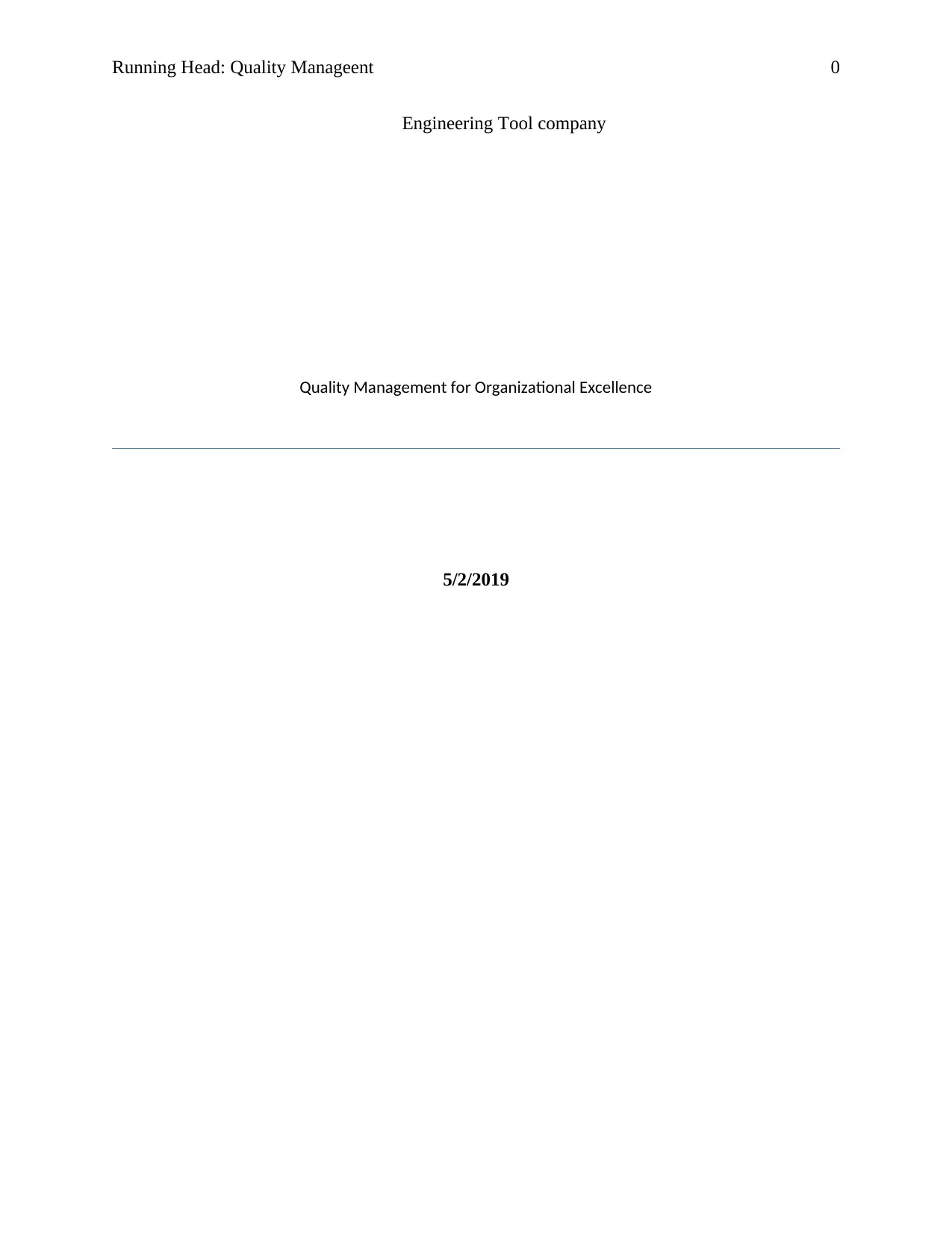
Running Head: Quality Manageent 0
Engineering Tool company
Quality Management for Organizational Excellence
5/2/2019
Engineering Tool company
Quality Management for Organizational Excellence
5/2/2019
Paraphrase This Document
Need a fresh take? Get an instant paraphrase of this document with our AI Paraphraser
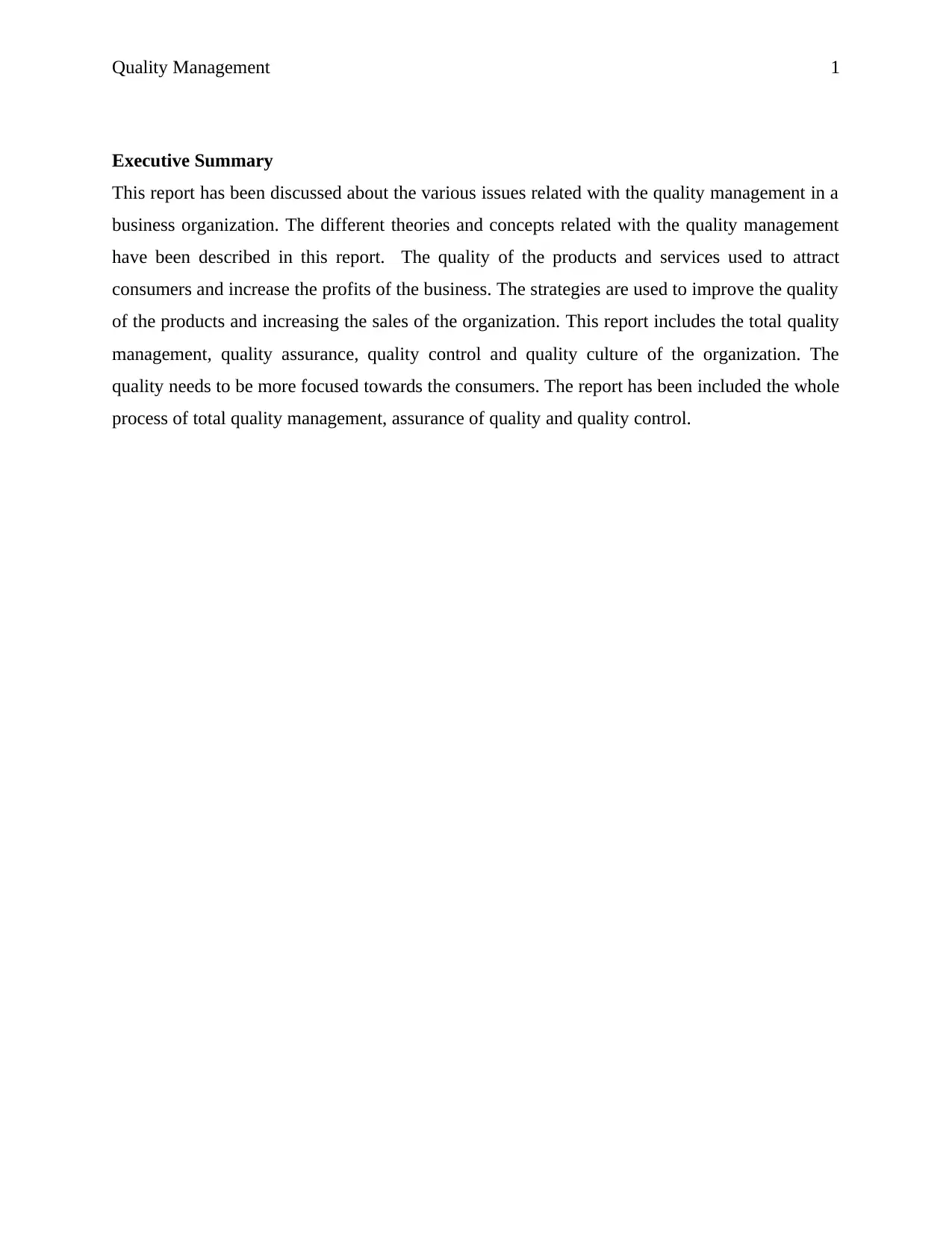
Quality Management 1
Executive Summary
This report has been discussed about the various issues related with the quality management in a
business organization. The different theories and concepts related with the quality management
have been described in this report. The quality of the products and services used to attract
consumers and increase the profits of the business. The strategies are used to improve the quality
of the products and increasing the sales of the organization. This report includes the total quality
management, quality assurance, quality control and quality culture of the organization. The
quality needs to be more focused towards the consumers. The report has been included the whole
process of total quality management, assurance of quality and quality control.
Executive Summary
This report has been discussed about the various issues related with the quality management in a
business organization. The different theories and concepts related with the quality management
have been described in this report. The quality of the products and services used to attract
consumers and increase the profits of the business. The strategies are used to improve the quality
of the products and increasing the sales of the organization. This report includes the total quality
management, quality assurance, quality control and quality culture of the organization. The
quality needs to be more focused towards the consumers. The report has been included the whole
process of total quality management, assurance of quality and quality control.

Quality Management 2
Contents
Executive Summary.........................................................................................................................1
Introduction......................................................................................................................................3
Theories and concepts of quality management and organizational excellence...............................4
Quality Assurance........................................................................................................................7
Quality control.............................................................................................................................8
The Quality culture......................................................................................................................9
Conclusion and Recommendations................................................................................................10
References......................................................................................................................................13
Contents
Executive Summary.........................................................................................................................1
Introduction......................................................................................................................................3
Theories and concepts of quality management and organizational excellence...............................4
Quality Assurance........................................................................................................................7
Quality control.............................................................................................................................8
The Quality culture......................................................................................................................9
Conclusion and Recommendations................................................................................................10
References......................................................................................................................................13
⊘ This is a preview!⊘
Do you want full access?
Subscribe today to unlock all pages.

Trusted by 1+ million students worldwide
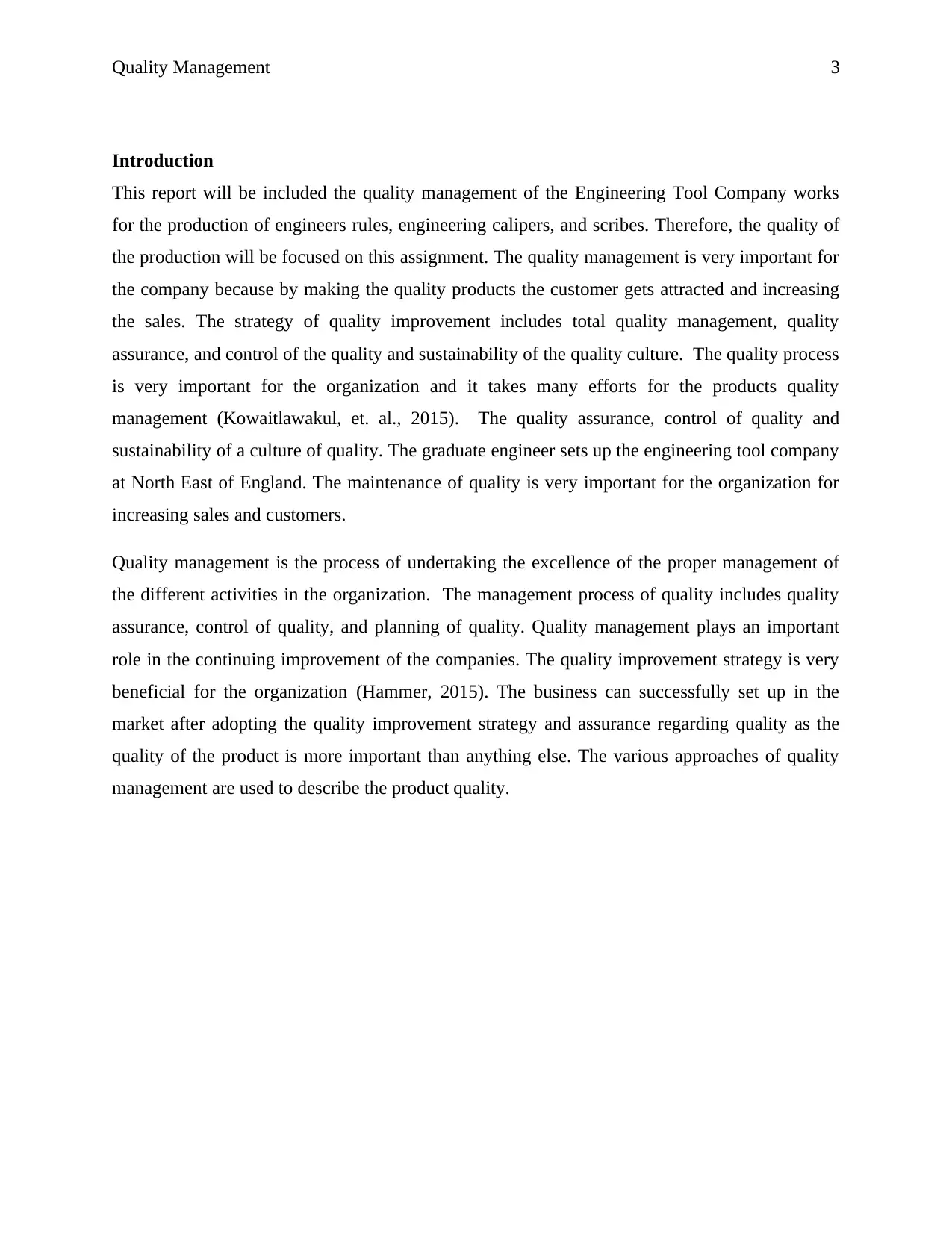
Quality Management 3
Introduction
This report will be included the quality management of the Engineering Tool Company works
for the production of engineers rules, engineering calipers, and scribes. Therefore, the quality of
the production will be focused on this assignment. The quality management is very important for
the company because by making the quality products the customer gets attracted and increasing
the sales. The strategy of quality improvement includes total quality management, quality
assurance, and control of the quality and sustainability of the quality culture. The quality process
is very important for the organization and it takes many efforts for the products quality
management (Kowaitlawakul, et. al., 2015). The quality assurance, control of quality and
sustainability of a culture of quality. The graduate engineer sets up the engineering tool company
at North East of England. The maintenance of quality is very important for the organization for
increasing sales and customers.
Quality management is the process of undertaking the excellence of the proper management of
the different activities in the organization. The management process of quality includes quality
assurance, control of quality, and planning of quality. Quality management plays an important
role in the continuing improvement of the companies. The quality improvement strategy is very
beneficial for the organization (Hammer, 2015). The business can successfully set up in the
market after adopting the quality improvement strategy and assurance regarding quality as the
quality of the product is more important than anything else. The various approaches of quality
management are used to describe the product quality.
Introduction
This report will be included the quality management of the Engineering Tool Company works
for the production of engineers rules, engineering calipers, and scribes. Therefore, the quality of
the production will be focused on this assignment. The quality management is very important for
the company because by making the quality products the customer gets attracted and increasing
the sales. The strategy of quality improvement includes total quality management, quality
assurance, and control of the quality and sustainability of the quality culture. The quality process
is very important for the organization and it takes many efforts for the products quality
management (Kowaitlawakul, et. al., 2015). The quality assurance, control of quality and
sustainability of a culture of quality. The graduate engineer sets up the engineering tool company
at North East of England. The maintenance of quality is very important for the organization for
increasing sales and customers.
Quality management is the process of undertaking the excellence of the proper management of
the different activities in the organization. The management process of quality includes quality
assurance, control of quality, and planning of quality. Quality management plays an important
role in the continuing improvement of the companies. The quality improvement strategy is very
beneficial for the organization (Hammer, 2015). The business can successfully set up in the
market after adopting the quality improvement strategy and assurance regarding quality as the
quality of the product is more important than anything else. The various approaches of quality
management are used to describe the product quality.
Paraphrase This Document
Need a fresh take? Get an instant paraphrase of this document with our AI Paraphraser
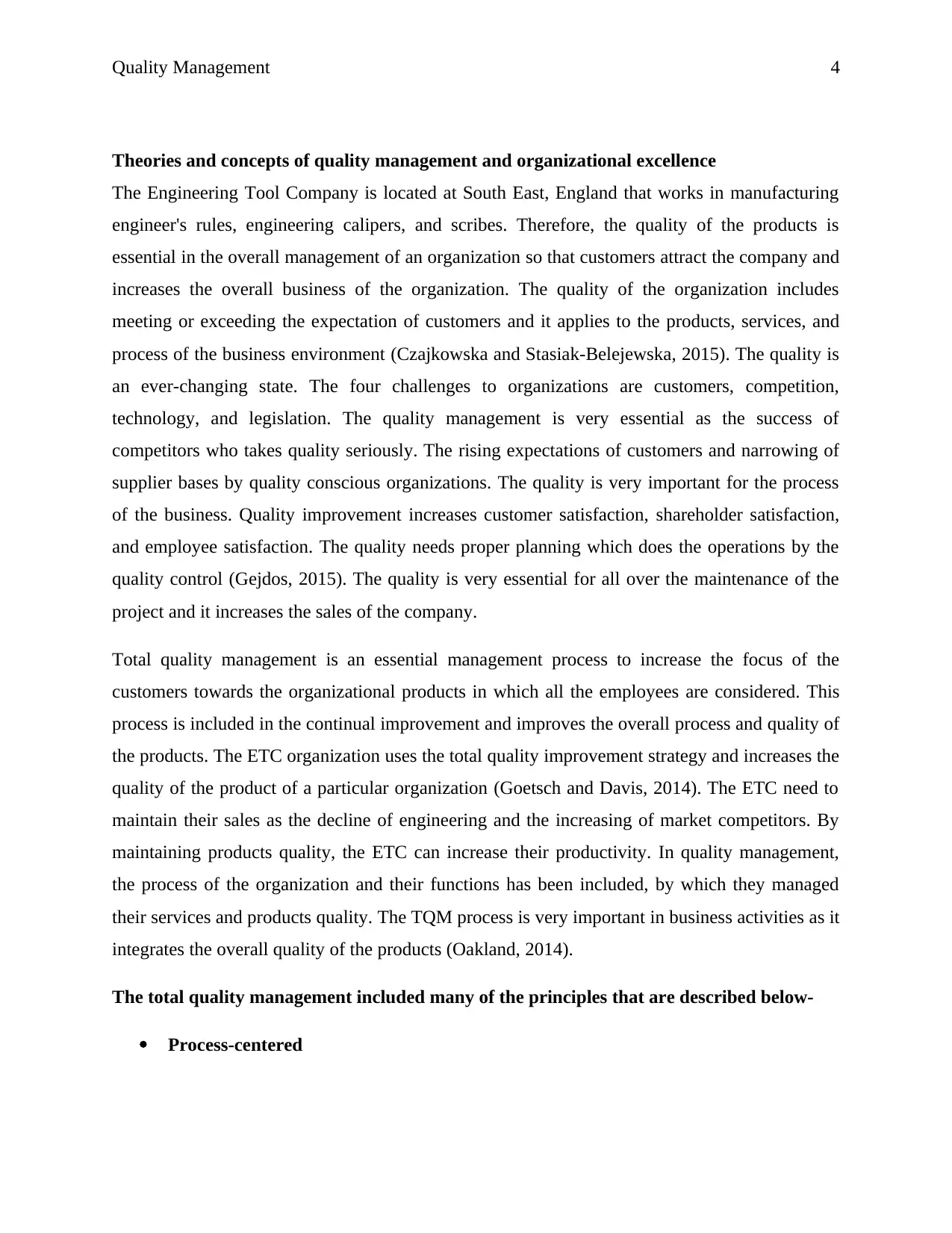
Quality Management 4
Theories and concepts of quality management and organizational excellence
The Engineering Tool Company is located at South East, England that works in manufacturing
engineer's rules, engineering calipers, and scribes. Therefore, the quality of the products is
essential in the overall management of an organization so that customers attract the company and
increases the overall business of the organization. The quality of the organization includes
meeting or exceeding the expectation of customers and it applies to the products, services, and
process of the business environment (Czajkowska and Stasiak-Belejewska, 2015). The quality is
an ever-changing state. The four challenges to organizations are customers, competition,
technology, and legislation. The quality management is very essential as the success of
competitors who takes quality seriously. The rising expectations of customers and narrowing of
supplier bases by quality conscious organizations. The quality is very important for the process
of the business. Quality improvement increases customer satisfaction, shareholder satisfaction,
and employee satisfaction. The quality needs proper planning which does the operations by the
quality control (Gejdos, 2015). The quality is very essential for all over the maintenance of the
project and it increases the sales of the company.
Total quality management is an essential management process to increase the focus of the
customers towards the organizational products in which all the employees are considered. This
process is included in the continual improvement and improves the overall process and quality of
the products. The ETC organization uses the total quality improvement strategy and increases the
quality of the product of a particular organization (Goetsch and Davis, 2014). The ETC need to
maintain their sales as the decline of engineering and the increasing of market competitors. By
maintaining products quality, the ETC can increase their productivity. In quality management,
the process of the organization and their functions has been included, by which they managed
their services and products quality. The TQM process is very important in business activities as it
integrates the overall quality of the products (Oakland, 2014).
The total quality management included many of the principles that are described below-
Process-centered
Theories and concepts of quality management and organizational excellence
The Engineering Tool Company is located at South East, England that works in manufacturing
engineer's rules, engineering calipers, and scribes. Therefore, the quality of the products is
essential in the overall management of an organization so that customers attract the company and
increases the overall business of the organization. The quality of the organization includes
meeting or exceeding the expectation of customers and it applies to the products, services, and
process of the business environment (Czajkowska and Stasiak-Belejewska, 2015). The quality is
an ever-changing state. The four challenges to organizations are customers, competition,
technology, and legislation. The quality management is very essential as the success of
competitors who takes quality seriously. The rising expectations of customers and narrowing of
supplier bases by quality conscious organizations. The quality is very important for the process
of the business. Quality improvement increases customer satisfaction, shareholder satisfaction,
and employee satisfaction. The quality needs proper planning which does the operations by the
quality control (Gejdos, 2015). The quality is very essential for all over the maintenance of the
project and it increases the sales of the company.
Total quality management is an essential management process to increase the focus of the
customers towards the organizational products in which all the employees are considered. This
process is included in the continual improvement and improves the overall process and quality of
the products. The ETC organization uses the total quality improvement strategy and increases the
quality of the product of a particular organization (Goetsch and Davis, 2014). The ETC need to
maintain their sales as the decline of engineering and the increasing of market competitors. By
maintaining products quality, the ETC can increase their productivity. In quality management,
the process of the organization and their functions has been included, by which they managed
their services and products quality. The TQM process is very important in business activities as it
integrates the overall quality of the products (Oakland, 2014).
The total quality management included many of the principles that are described below-
Process-centered
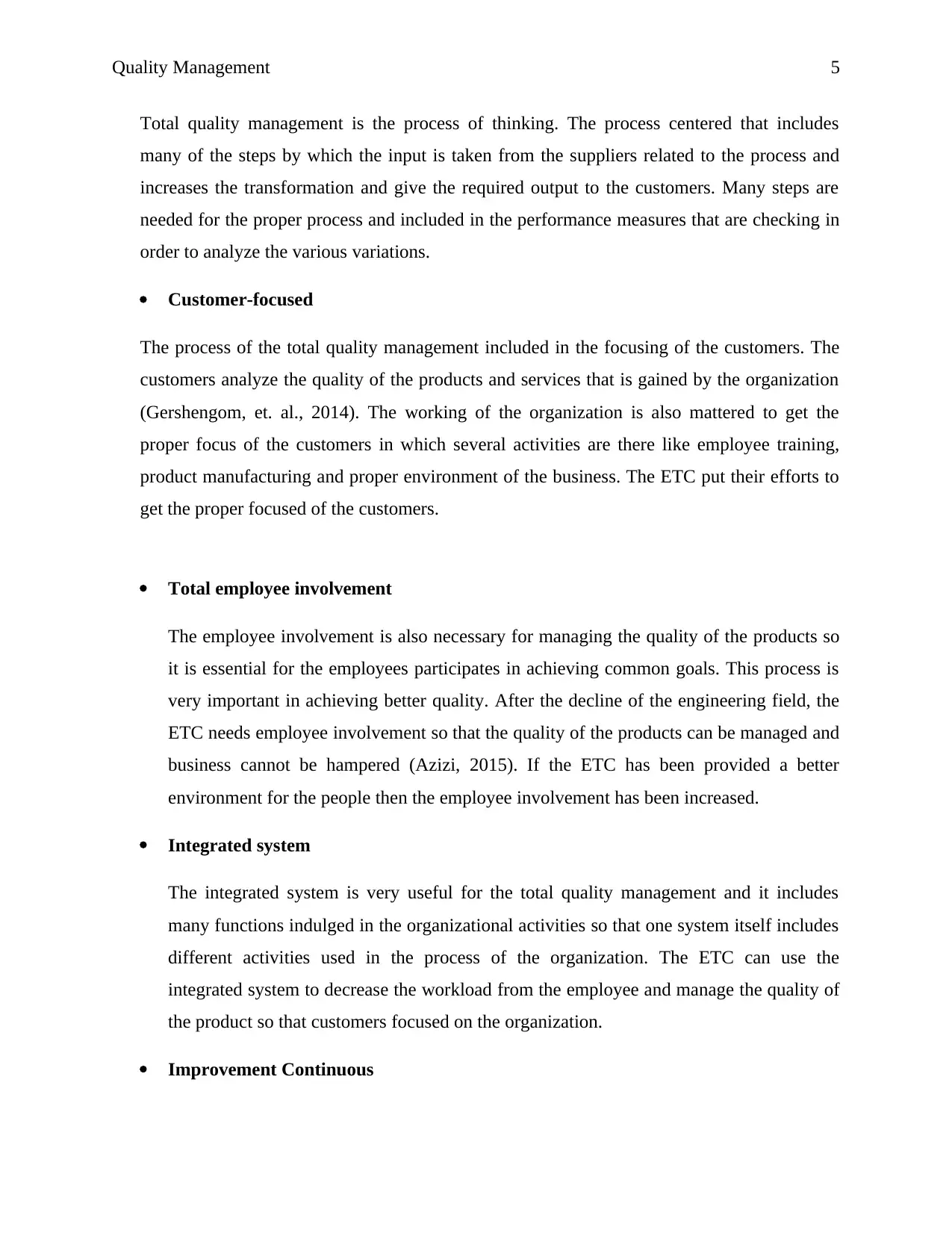
Quality Management 5
Total quality management is the process of thinking. The process centered that includes
many of the steps by which the input is taken from the suppliers related to the process and
increases the transformation and give the required output to the customers. Many steps are
needed for the proper process and included in the performance measures that are checking in
order to analyze the various variations.
Customer-focused
The process of the total quality management included in the focusing of the customers. The
customers analyze the quality of the products and services that is gained by the organization
(Gershengom, et. al., 2014). The working of the organization is also mattered to get the
proper focus of the customers in which several activities are there like employee training,
product manufacturing and proper environment of the business. The ETC put their efforts to
get the proper focused of the customers.
Total employee involvement
The employee involvement is also necessary for managing the quality of the products so
it is essential for the employees participates in achieving common goals. This process is
very important in achieving better quality. After the decline of the engineering field, the
ETC needs employee involvement so that the quality of the products can be managed and
business cannot be hampered (Azizi, 2015). If the ETC has been provided a better
environment for the people then the employee involvement has been increased.
Integrated system
The integrated system is very useful for the total quality management and it includes
many functions indulged in the organizational activities so that one system itself includes
different activities used in the process of the organization. The ETC can use the
integrated system to decrease the workload from the employee and manage the quality of
the product so that customers focused on the organization.
Improvement Continuous
Total quality management is the process of thinking. The process centered that includes
many of the steps by which the input is taken from the suppliers related to the process and
increases the transformation and give the required output to the customers. Many steps are
needed for the proper process and included in the performance measures that are checking in
order to analyze the various variations.
Customer-focused
The process of the total quality management included in the focusing of the customers. The
customers analyze the quality of the products and services that is gained by the organization
(Gershengom, et. al., 2014). The working of the organization is also mattered to get the
proper focus of the customers in which several activities are there like employee training,
product manufacturing and proper environment of the business. The ETC put their efforts to
get the proper focused of the customers.
Total employee involvement
The employee involvement is also necessary for managing the quality of the products so
it is essential for the employees participates in achieving common goals. This process is
very important in achieving better quality. After the decline of the engineering field, the
ETC needs employee involvement so that the quality of the products can be managed and
business cannot be hampered (Azizi, 2015). If the ETC has been provided a better
environment for the people then the employee involvement has been increased.
Integrated system
The integrated system is very useful for the total quality management and it includes
many functions indulged in the organizational activities so that one system itself includes
different activities used in the process of the organization. The ETC can use the
integrated system to decrease the workload from the employee and manage the quality of
the product so that customers focused on the organization.
Improvement Continuous
⊘ This is a preview!⊘
Do you want full access?
Subscribe today to unlock all pages.

Trusted by 1+ million students worldwide
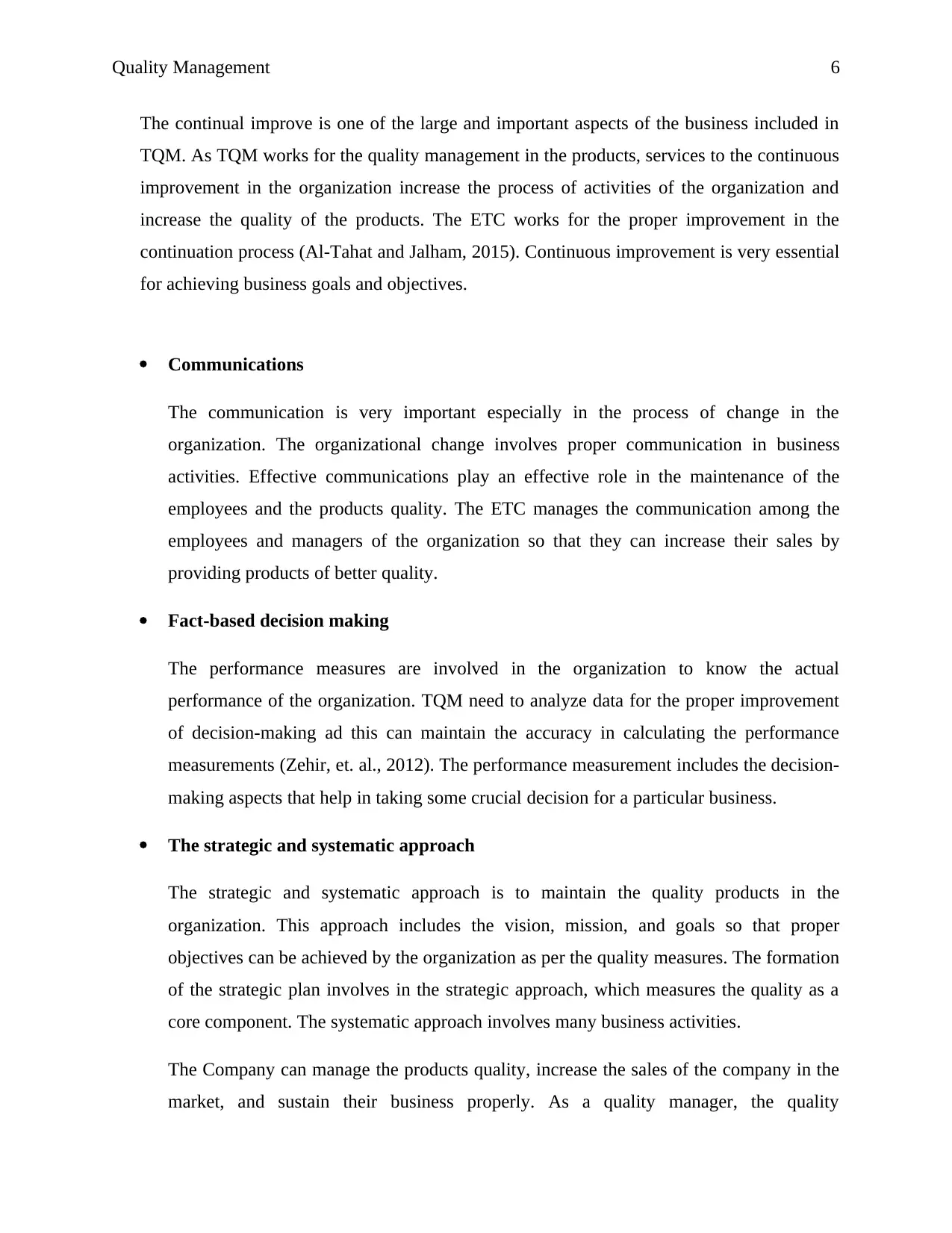
Quality Management 6
The continual improve is one of the large and important aspects of the business included in
TQM. As TQM works for the quality management in the products, services to the continuous
improvement in the organization increase the process of activities of the organization and
increase the quality of the products. The ETC works for the proper improvement in the
continuation process (Al-Tahat and Jalham, 2015). Continuous improvement is very essential
for achieving business goals and objectives.
Communications
The communication is very important especially in the process of change in the
organization. The organizational change involves proper communication in business
activities. Effective communications play an effective role in the maintenance of the
employees and the products quality. The ETC manages the communication among the
employees and managers of the organization so that they can increase their sales by
providing products of better quality.
Fact-based decision making
The performance measures are involved in the organization to know the actual
performance of the organization. TQM need to analyze data for the proper improvement
of decision-making ad this can maintain the accuracy in calculating the performance
measurements (Zehir, et. al., 2012). The performance measurement includes the decision-
making aspects that help in taking some crucial decision for a particular business.
The strategic and systematic approach
The strategic and systematic approach is to maintain the quality products in the
organization. This approach includes the vision, mission, and goals so that proper
objectives can be achieved by the organization as per the quality measures. The formation
of the strategic plan involves in the strategic approach, which measures the quality as a
core component. The systematic approach involves many business activities.
The Company can manage the products quality, increase the sales of the company in the
market, and sustain their business properly. As a quality manager, the quality
The continual improve is one of the large and important aspects of the business included in
TQM. As TQM works for the quality management in the products, services to the continuous
improvement in the organization increase the process of activities of the organization and
increase the quality of the products. The ETC works for the proper improvement in the
continuation process (Al-Tahat and Jalham, 2015). Continuous improvement is very essential
for achieving business goals and objectives.
Communications
The communication is very important especially in the process of change in the
organization. The organizational change involves proper communication in business
activities. Effective communications play an effective role in the maintenance of the
employees and the products quality. The ETC manages the communication among the
employees and managers of the organization so that they can increase their sales by
providing products of better quality.
Fact-based decision making
The performance measures are involved in the organization to know the actual
performance of the organization. TQM need to analyze data for the proper improvement
of decision-making ad this can maintain the accuracy in calculating the performance
measurements (Zehir, et. al., 2012). The performance measurement includes the decision-
making aspects that help in taking some crucial decision for a particular business.
The strategic and systematic approach
The strategic and systematic approach is to maintain the quality products in the
organization. This approach includes the vision, mission, and goals so that proper
objectives can be achieved by the organization as per the quality measures. The formation
of the strategic plan involves in the strategic approach, which measures the quality as a
core component. The systematic approach involves many business activities.
The Company can manage the products quality, increase the sales of the company in the
market, and sustain their business properly. As a quality manager, the quality
Paraphrase This Document
Need a fresh take? Get an instant paraphrase of this document with our AI Paraphraser
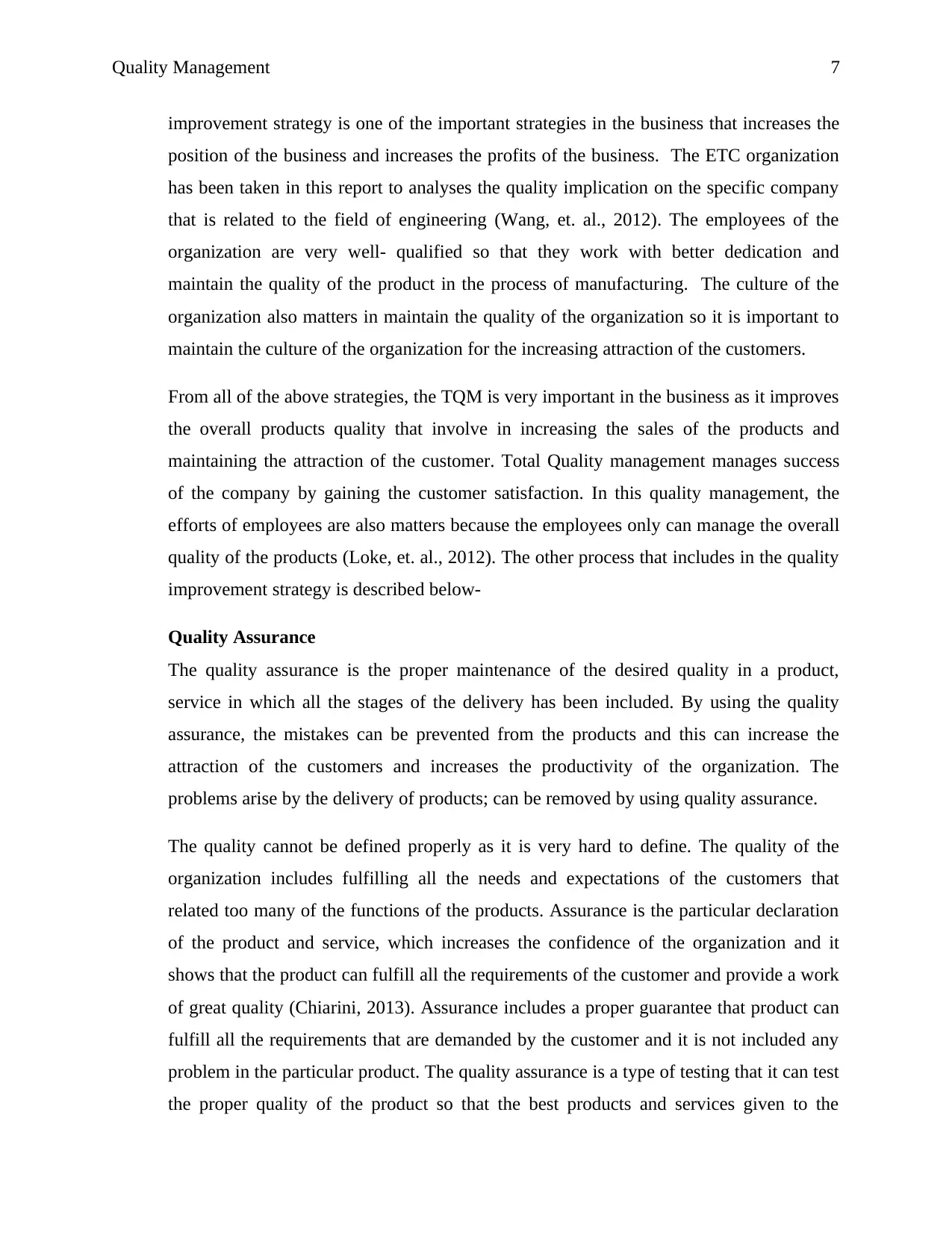
Quality Management 7
improvement strategy is one of the important strategies in the business that increases the
position of the business and increases the profits of the business. The ETC organization
has been taken in this report to analyses the quality implication on the specific company
that is related to the field of engineering (Wang, et. al., 2012). The employees of the
organization are very well- qualified so that they work with better dedication and
maintain the quality of the product in the process of manufacturing. The culture of the
organization also matters in maintain the quality of the organization so it is important to
maintain the culture of the organization for the increasing attraction of the customers.
From all of the above strategies, the TQM is very important in the business as it improves
the overall products quality that involve in increasing the sales of the products and
maintaining the attraction of the customer. Total Quality management manages success
of the company by gaining the customer satisfaction. In this quality management, the
efforts of employees are also matters because the employees only can manage the overall
quality of the products (Loke, et. al., 2012). The other process that includes in the quality
improvement strategy is described below-
Quality Assurance
The quality assurance is the proper maintenance of the desired quality in a product,
service in which all the stages of the delivery has been included. By using the quality
assurance, the mistakes can be prevented from the products and this can increase the
attraction of the customers and increases the productivity of the organization. The
problems arise by the delivery of products; can be removed by using quality assurance.
The quality cannot be defined properly as it is very hard to define. The quality of the
organization includes fulfilling all the needs and expectations of the customers that
related too many of the functions of the products. Assurance is the particular declaration
of the product and service, which increases the confidence of the organization and it
shows that the product can fulfill all the requirements of the customer and provide a work
of great quality (Chiarini, 2013). Assurance includes a proper guarantee that product can
fulfill all the requirements that are demanded by the customer and it is not included any
problem in the particular product. The quality assurance is a type of testing that it can test
the proper quality of the product so that the best products and services given to the
improvement strategy is one of the important strategies in the business that increases the
position of the business and increases the profits of the business. The ETC organization
has been taken in this report to analyses the quality implication on the specific company
that is related to the field of engineering (Wang, et. al., 2012). The employees of the
organization are very well- qualified so that they work with better dedication and
maintain the quality of the product in the process of manufacturing. The culture of the
organization also matters in maintain the quality of the organization so it is important to
maintain the culture of the organization for the increasing attraction of the customers.
From all of the above strategies, the TQM is very important in the business as it improves
the overall products quality that involve in increasing the sales of the products and
maintaining the attraction of the customer. Total Quality management manages success
of the company by gaining the customer satisfaction. In this quality management, the
efforts of employees are also matters because the employees only can manage the overall
quality of the products (Loke, et. al., 2012). The other process that includes in the quality
improvement strategy is described below-
Quality Assurance
The quality assurance is the proper maintenance of the desired quality in a product,
service in which all the stages of the delivery has been included. By using the quality
assurance, the mistakes can be prevented from the products and this can increase the
attraction of the customers and increases the productivity of the organization. The
problems arise by the delivery of products; can be removed by using quality assurance.
The quality cannot be defined properly as it is very hard to define. The quality of the
organization includes fulfilling all the needs and expectations of the customers that
related too many of the functions of the products. Assurance is the particular declaration
of the product and service, which increases the confidence of the organization and it
shows that the product can fulfill all the requirements of the customer and provide a work
of great quality (Chiarini, 2013). Assurance includes a proper guarantee that product can
fulfill all the requirements that are demanded by the customer and it is not included any
problem in the particular product. The quality assurance is a type of testing that it can test
the proper quality of the product so that the best products and services given to the
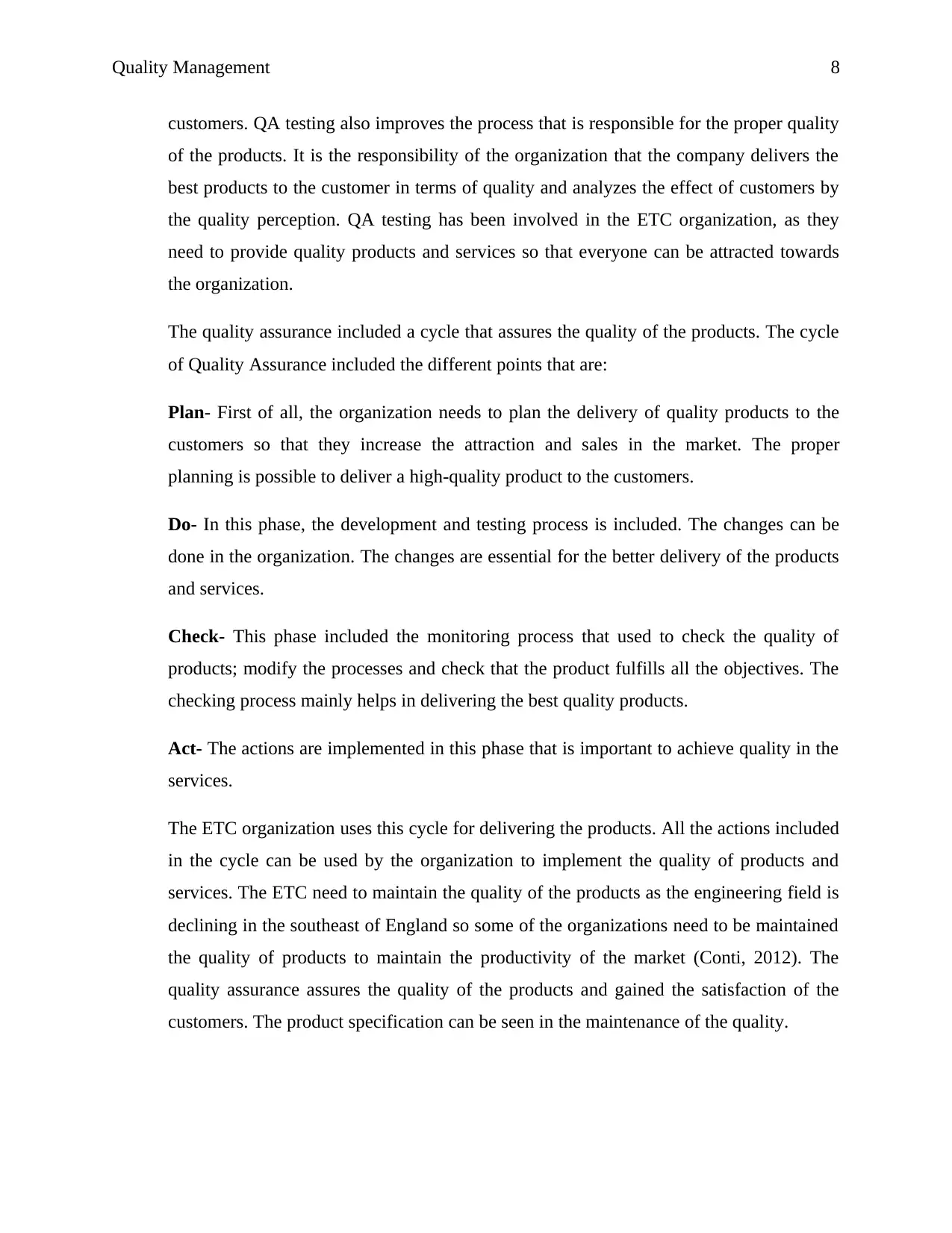
Quality Management 8
customers. QA testing also improves the process that is responsible for the proper quality
of the products. It is the responsibility of the organization that the company delivers the
best products to the customer in terms of quality and analyzes the effect of customers by
the quality perception. QA testing has been involved in the ETC organization, as they
need to provide quality products and services so that everyone can be attracted towards
the organization.
The quality assurance included a cycle that assures the quality of the products. The cycle
of Quality Assurance included the different points that are:
Plan- First of all, the organization needs to plan the delivery of quality products to the
customers so that they increase the attraction and sales in the market. The proper
planning is possible to deliver a high-quality product to the customers.
Do- In this phase, the development and testing process is included. The changes can be
done in the organization. The changes are essential for the better delivery of the products
and services.
Check- This phase included the monitoring process that used to check the quality of
products; modify the processes and check that the product fulfills all the objectives. The
checking process mainly helps in delivering the best quality products.
Act- The actions are implemented in this phase that is important to achieve quality in the
services.
The ETC organization uses this cycle for delivering the products. All the actions included
in the cycle can be used by the organization to implement the quality of products and
services. The ETC need to maintain the quality of the products as the engineering field is
declining in the southeast of England so some of the organizations need to be maintained
the quality of products to maintain the productivity of the market (Conti, 2012). The
quality assurance assures the quality of the products and gained the satisfaction of the
customers. The product specification can be seen in the maintenance of the quality.
customers. QA testing also improves the process that is responsible for the proper quality
of the products. It is the responsibility of the organization that the company delivers the
best products to the customer in terms of quality and analyzes the effect of customers by
the quality perception. QA testing has been involved in the ETC organization, as they
need to provide quality products and services so that everyone can be attracted towards
the organization.
The quality assurance included a cycle that assures the quality of the products. The cycle
of Quality Assurance included the different points that are:
Plan- First of all, the organization needs to plan the delivery of quality products to the
customers so that they increase the attraction and sales in the market. The proper
planning is possible to deliver a high-quality product to the customers.
Do- In this phase, the development and testing process is included. The changes can be
done in the organization. The changes are essential for the better delivery of the products
and services.
Check- This phase included the monitoring process that used to check the quality of
products; modify the processes and check that the product fulfills all the objectives. The
checking process mainly helps in delivering the best quality products.
Act- The actions are implemented in this phase that is important to achieve quality in the
services.
The ETC organization uses this cycle for delivering the products. All the actions included
in the cycle can be used by the organization to implement the quality of products and
services. The ETC need to maintain the quality of the products as the engineering field is
declining in the southeast of England so some of the organizations need to be maintained
the quality of products to maintain the productivity of the market (Conti, 2012). The
quality assurance assures the quality of the products and gained the satisfaction of the
customers. The product specification can be seen in the maintenance of the quality.
⊘ This is a preview!⊘
Do you want full access?
Subscribe today to unlock all pages.

Trusted by 1+ million students worldwide
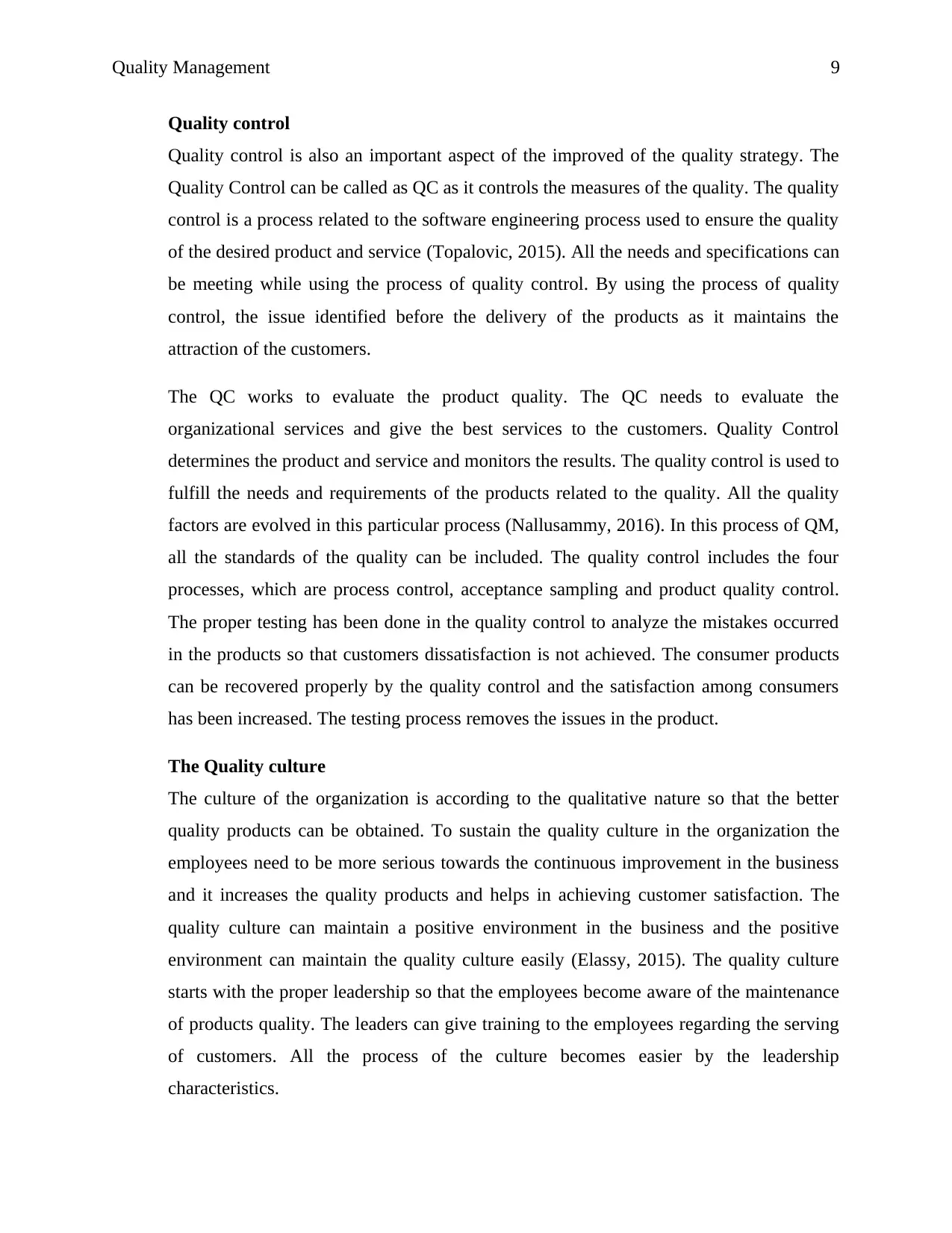
Quality Management 9
Quality control
Quality control is also an important aspect of the improved of the quality strategy. The
Quality Control can be called as QC as it controls the measures of the quality. The quality
control is a process related to the software engineering process used to ensure the quality
of the desired product and service (Topalovic, 2015). All the needs and specifications can
be meeting while using the process of quality control. By using the process of quality
control, the issue identified before the delivery of the products as it maintains the
attraction of the customers.
The QC works to evaluate the product quality. The QC needs to evaluate the
organizational services and give the best services to the customers. Quality Control
determines the product and service and monitors the results. The quality control is used to
fulfill the needs and requirements of the products related to the quality. All the quality
factors are evolved in this particular process (Nallusammy, 2016). In this process of QM,
all the standards of the quality can be included. The quality control includes the four
processes, which are process control, acceptance sampling and product quality control.
The proper testing has been done in the quality control to analyze the mistakes occurred
in the products so that customers dissatisfaction is not achieved. The consumer products
can be recovered properly by the quality control and the satisfaction among consumers
has been increased. The testing process removes the issues in the product.
The Quality culture
The culture of the organization is according to the qualitative nature so that the better
quality products can be obtained. To sustain the quality culture in the organization the
employees need to be more serious towards the continuous improvement in the business
and it increases the quality products and helps in achieving customer satisfaction. The
quality culture can maintain a positive environment in the business and the positive
environment can maintain the quality culture easily (Elassy, 2015). The quality culture
starts with the proper leadership so that the employees become aware of the maintenance
of products quality. The leaders can give training to the employees regarding the serving
of customers. All the process of the culture becomes easier by the leadership
characteristics.
Quality control
Quality control is also an important aspect of the improved of the quality strategy. The
Quality Control can be called as QC as it controls the measures of the quality. The quality
control is a process related to the software engineering process used to ensure the quality
of the desired product and service (Topalovic, 2015). All the needs and specifications can
be meeting while using the process of quality control. By using the process of quality
control, the issue identified before the delivery of the products as it maintains the
attraction of the customers.
The QC works to evaluate the product quality. The QC needs to evaluate the
organizational services and give the best services to the customers. Quality Control
determines the product and service and monitors the results. The quality control is used to
fulfill the needs and requirements of the products related to the quality. All the quality
factors are evolved in this particular process (Nallusammy, 2016). In this process of QM,
all the standards of the quality can be included. The quality control includes the four
processes, which are process control, acceptance sampling and product quality control.
The proper testing has been done in the quality control to analyze the mistakes occurred
in the products so that customers dissatisfaction is not achieved. The consumer products
can be recovered properly by the quality control and the satisfaction among consumers
has been increased. The testing process removes the issues in the product.
The Quality culture
The culture of the organization is according to the qualitative nature so that the better
quality products can be obtained. To sustain the quality culture in the organization the
employees need to be more serious towards the continuous improvement in the business
and it increases the quality products and helps in achieving customer satisfaction. The
quality culture can maintain a positive environment in the business and the positive
environment can maintain the quality culture easily (Elassy, 2015). The quality culture
starts with the proper leadership so that the employees become aware of the maintenance
of products quality. The leaders can give training to the employees regarding the serving
of customers. All the process of the culture becomes easier by the leadership
characteristics.
Paraphrase This Document
Need a fresh take? Get an instant paraphrase of this document with our AI Paraphraser
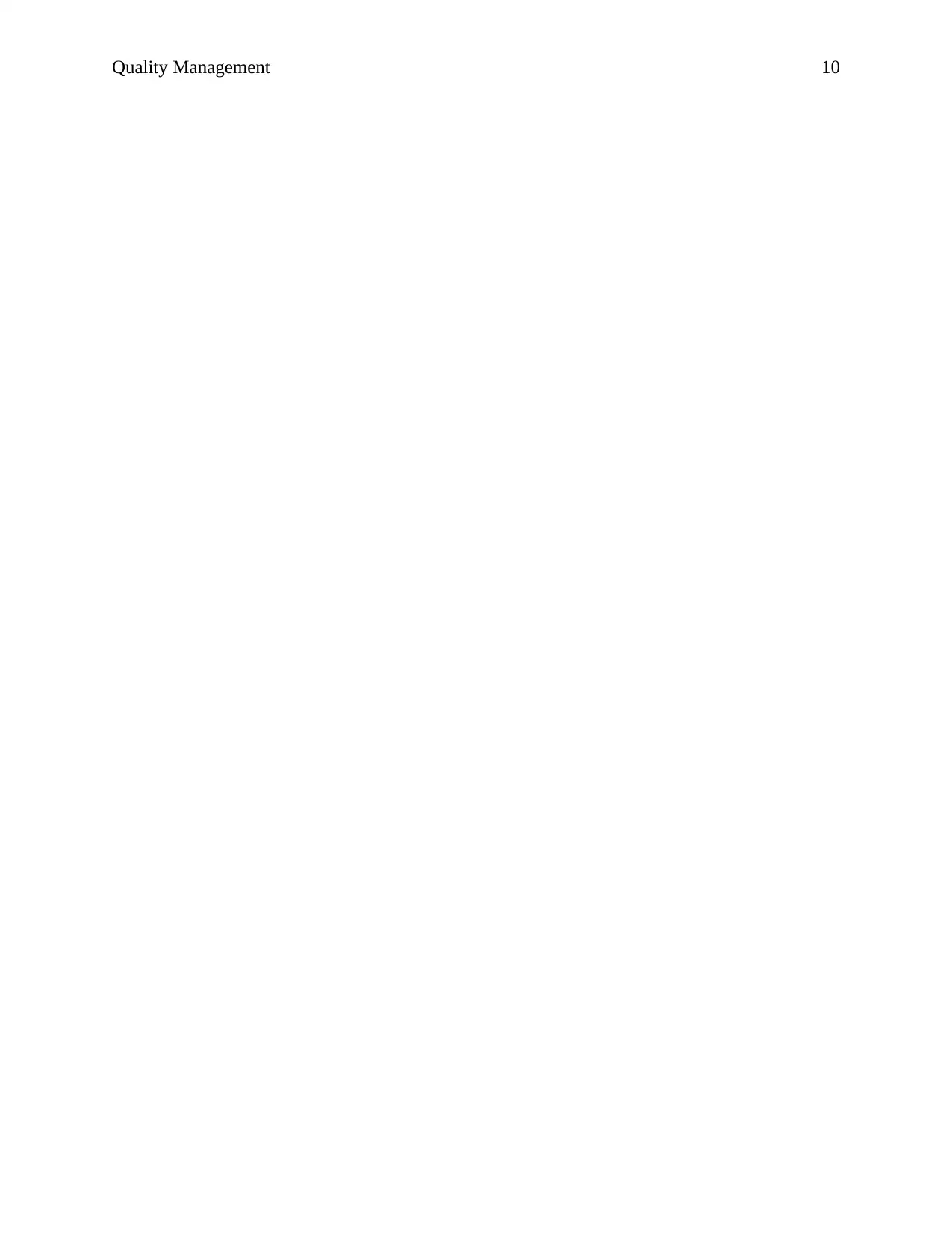
Quality Management 10
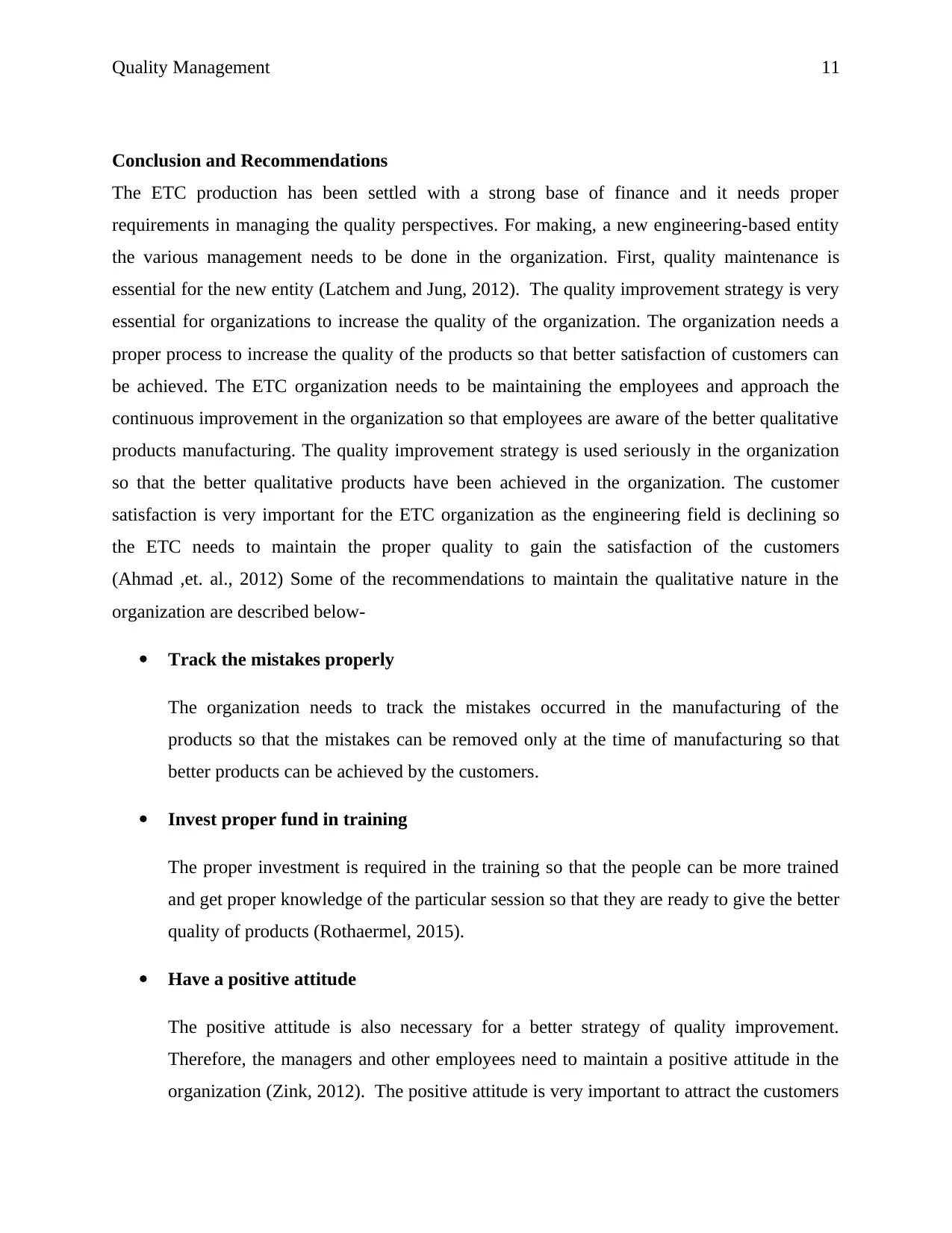
Quality Management 11
Conclusion and Recommendations
The ETC production has been settled with a strong base of finance and it needs proper
requirements in managing the quality perspectives. For making, a new engineering-based entity
the various management needs to be done in the organization. First, quality maintenance is
essential for the new entity (Latchem and Jung, 2012). The quality improvement strategy is very
essential for organizations to increase the quality of the organization. The organization needs a
proper process to increase the quality of the products so that better satisfaction of customers can
be achieved. The ETC organization needs to be maintaining the employees and approach the
continuous improvement in the organization so that employees are aware of the better qualitative
products manufacturing. The quality improvement strategy is used seriously in the organization
so that the better qualitative products have been achieved in the organization. The customer
satisfaction is very important for the ETC organization as the engineering field is declining so
the ETC needs to maintain the proper quality to gain the satisfaction of the customers
(Ahmad ,et. al., 2012) Some of the recommendations to maintain the qualitative nature in the
organization are described below-
Track the mistakes properly
The organization needs to track the mistakes occurred in the manufacturing of the
products so that the mistakes can be removed only at the time of manufacturing so that
better products can be achieved by the customers.
Invest proper fund in training
The proper investment is required in the training so that the people can be more trained
and get proper knowledge of the particular session so that they are ready to give the better
quality of products (Rothaermel, 2015).
Have a positive attitude
The positive attitude is also necessary for a better strategy of quality improvement.
Therefore, the managers and other employees need to maintain a positive attitude in the
organization (Zink, 2012). The positive attitude is very important to attract the customers
Conclusion and Recommendations
The ETC production has been settled with a strong base of finance and it needs proper
requirements in managing the quality perspectives. For making, a new engineering-based entity
the various management needs to be done in the organization. First, quality maintenance is
essential for the new entity (Latchem and Jung, 2012). The quality improvement strategy is very
essential for organizations to increase the quality of the organization. The organization needs a
proper process to increase the quality of the products so that better satisfaction of customers can
be achieved. The ETC organization needs to be maintaining the employees and approach the
continuous improvement in the organization so that employees are aware of the better qualitative
products manufacturing. The quality improvement strategy is used seriously in the organization
so that the better qualitative products have been achieved in the organization. The customer
satisfaction is very important for the ETC organization as the engineering field is declining so
the ETC needs to maintain the proper quality to gain the satisfaction of the customers
(Ahmad ,et. al., 2012) Some of the recommendations to maintain the qualitative nature in the
organization are described below-
Track the mistakes properly
The organization needs to track the mistakes occurred in the manufacturing of the
products so that the mistakes can be removed only at the time of manufacturing so that
better products can be achieved by the customers.
Invest proper fund in training
The proper investment is required in the training so that the people can be more trained
and get proper knowledge of the particular session so that they are ready to give the better
quality of products (Rothaermel, 2015).
Have a positive attitude
The positive attitude is also necessary for a better strategy of quality improvement.
Therefore, the managers and other employees need to maintain a positive attitude in the
organization (Zink, 2012). The positive attitude is very important to attract the customers
⊘ This is a preview!⊘
Do you want full access?
Subscribe today to unlock all pages.

Trusted by 1+ million students worldwide
1 out of 17
Related Documents
Your All-in-One AI-Powered Toolkit for Academic Success.
+13062052269
info@desklib.com
Available 24*7 on WhatsApp / Email
![[object Object]](/_next/static/media/star-bottom.7253800d.svg)
Unlock your academic potential
Copyright © 2020–2025 A2Z Services. All Rights Reserved. Developed and managed by ZUCOL.





